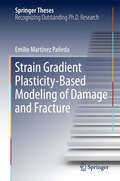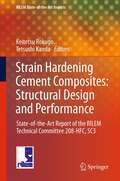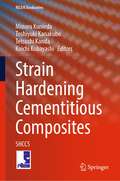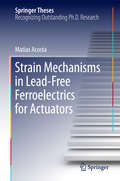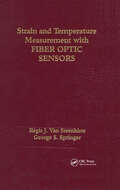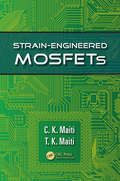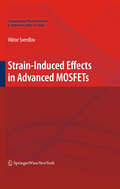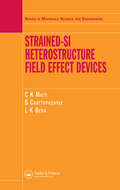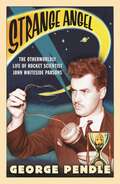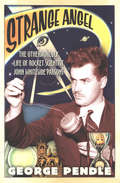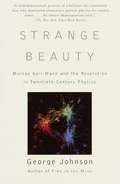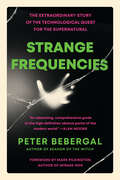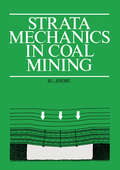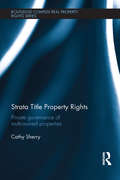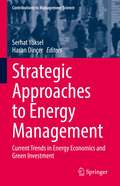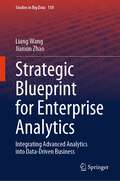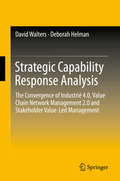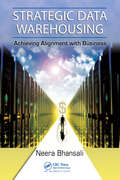- Table View
- List View
Straight On till Morning: The Biography of Beryl Markham
by Mary S. LovellBeryl Markham, was the first person to fly solo from England to America. The full story of her adventures across three continents are revealed in this biography of a lady whose fame was only exceeded by her beauty and controversial character.
Strain Gradient Plasticity-Based Modeling of Damage and Fracture
by Emilio Martínez PañedaThis book provides a comprehensive introduction to numerical modeling of size effects in metal plasticity. The main classes of strain gradient plasticity formulations are described and efficiently implemented in the context of the finite element method. A robust numerical framework is presented and employed to investigate the role of strain gradients on structural integrity assessment. The results obtained reveal the need of incorporating the influence on geometrically necessary dislocations in the modeling of various damage mechanisms. Large gradients of plastic strain increase dislocation density, promoting strain hardening and elevating crack tip stresses. This stress elevation is quantified under both infinitesimal and finite deformation theories, rationalizing the experimental observation of cleavage fracture in the presence of significant plastic flow. Gradient-enhanced modeling of crack growth resistance, hydrogen diffusion and environmentally assisted cracking highlighted the relevance of an appropriate characterization of the mechanical response at the small scales involved in crack tip deformation. Particularly promising predictions are attained in the field of hydrogen embrittlement. The research has been conducted at the Universities of Cambridge, Oviedo, Luxembourg, and the Technical University of Denmark, in a collaborative effort to understand, model and optimize the mechanical response of engineering materials.
Strain Hardening Cement Composites: Structural Design and Performance
by Volker Slowik Yuichi Uchida Kanakubo Toshiyuki Haruhiko Suwada Tetsushi Kanda Keitetsu Rokugo Hiroshi Fukuyama Petr KabeleStrain Hardening Cement Composites, SHCC hereafter, demonstrate excellent mechanical behavior showing tensile strain hardening and multiple fine cracks. This strain hardening behavior improves the durability of concrete structures employing SHCC and the multiple fine cracks enhance structural performance. Reliable tensile performance of SHCC enables us to design structures explicitly accounting for SHCC's tensile properties. Reinforced SHCC elements (R/SHCC) indicate large energy absorbing performance under large seismic excitation. Against various types of loads, R/SHCC elements can be designed by superimposing re-bar performance and SHCC's tensile performance. This report focuses on flexural design, shear design, FE modeling and anti-seismic design of R/SHCC elements as well as application examples. Establishing design methods for new materials usually leads to exploring application areas and this trend should be demonstrated by collecting actual application examples of SHCC in structures.
Strain Hardening Cementitious Composites: Special Collection Of Shcc5 (Rilem Bookseries Series #39)
by Tetsushi Kanda Koichi Kobayashi Minoru Kunieda Toshiyuki Kanakubo<p>Presents the latest advances and innovative practices in the field of fibre reinforced concrete<p> <p>Bridges the gap between scientific research and applied engineering<p> <p>Written by leading experts in the field<p>
Strain Mechanisms in Lead-Free Ferroelectrics for Actuators
by Matias AcostaThis book addresses and analyzes the mechanisms responsible for functionality of two technologically relevant materials, giving emphasis on the relationship between structural transitions and electromechanical properties. The author investigates the atomic crystal structure and microstructure by means of thermal analysis, as well as diffraction and microscopy techniques. Electric field-, temperature- and frequency-dependent electromechanical properties are also described. Apart from this correlation between structure and properties, characterization was also performed to bridge between basic research and optimization of application-oriented parameters required for technological implementation. The author proposes guidelines to the reader in order to engineer functional properties in other piezoelectric systems, as well as in other similar functional materials with the perovskite structure.
Strain and Temperature Measurement with Fiber Optic Sensors
by Regis J. Van SteenkisteSensors operating on interferometric principles and mounted inside optical fibers have recently been considered for measuring strain and temperature. Indeed, such sensors have successfully been employed for measuring pressure or temperature in fluids. Fiber optics sensors are especially adept for such measurements because sensors immersed in fluids can easily be calibrated by tests.Unfortunately, the use of fiber optic sensors inside solids is not as straightforward. Owing to the complex interactions between the sensor and the surrounding material, the relationship between the sensor output and the parameters of interest, namely the strain and temperature inside the material, cannot be determined by simple tests. And without the appropriate relationships, fiber optic sensors do not provide meaningful information. In general, the relationship providing the bridge between the sensor output and the engineering values of strain and temperature must be established via analytical models. The major aim of this book is to present such models for extrinsic and intrinsic Fabry-Perot sensors and for Bragg grating sensors embedded in or mounted on the surface of isotropic or anisotropic solids or immersed in fluids.The scope of the book is limited to the theory of fiber optic strain and temperature sensors. Accordingly, we have taken as our starting point the demodulated sensor signals. The hardware needed to produce these signals is not discussed. It is presumed that the reader is familiar with and has access to the sensor, light source, light detector and demodulator required for generating signals which can then be analyzed and interpreted by the methods presented in the book.The problem necessitates complex analytical developments. To assist the reader, the significant results are summarized in tables, and numerical examples are given illustrating the calculation procedures.
Strain-Engineered MOSFETs
by C.K. Maiti T.K. MaitiCurrently strain engineering is the main technique used to enhance the performance of advanced silicon-based metal-oxide-semiconductor field-effect transistors (MOSFETs). Written from an engineering application standpoint, Strain-Engineered MOSFETs introduces promising strain techniques to fabricate strain-engineered MOSFETs and to methods to assess the applications of these techniques. The book provides the background and physical insight needed to understand new and future developments in the modeling and design of n- and p-MOSFETs at nanoscale. This book focuses on recent developments in strain-engineered MOSFETS implemented in high-mobility substrates such as, Ge, SiGe, strained-Si, ultrathin germanium-on-insulator platforms, combined with high-k insulators and metal-gate. It covers the materials aspects, principles, and design of advanced devices, fabrication, and applications. It also presents a full technology computer aided design (TCAD) methodology for strain-engineering in Si-CMOS technology involving data flow from process simulation to process variability simulation via device simulation and generation of SPICE process compact models for manufacturing for yield optimization.Microelectronics fabrication is facing serious challenges due to the introduction of new materials in manufacturing and fundamental limitations of nanoscale devices that result in increasing unpredictability in the characteristics of the devices. The down scaling of CMOS technologies has brought about the increased variability of key parameters affecting the performance of integrated circuits. This book provides a single text that combines coverage of the strain-engineered MOSFETS and their modeling using TCAD, making it a tool for process technology development and the design of strain-engineered MOSFETs.
Strain-Induced Effects in Advanced MOSFETs
by Viktor SverdlovStrain is used to boost performance of MOSFETs. Modeling of strain effects on transport is an important task of modern simulation tools required for device design. The book covers all relevant modeling approaches used to describe strain in silicon. The subband structure in stressed semiconductor films is investigated in devices using analytical k.p and numerical pseudopotential methods. A rigorous overview of transport modeling in strained devices is given.
Strained-Si Heterostructure Field Effect Devices (Series in Materials Science and Engineering)
by C.K Maiti S Chattopadhyay L.K BeraA combination of the materials science, manufacturing processes, and pioneering research and developments of SiGe and strained-Si have offered an unprecedented high level of performance enhancement at low manufacturing costs. Encompassing all of these areas, Strained-Si Heterostructure Field Effect Devices addresses the research needs associated wi
Strand Corrosion in Prestressed Concrete Structures
by Lei WangThis is an open access book. This book focuses on the durability problems of existing prestressed concrete (PC) structures caused by strand corrosion, clarifies the mechanical behavior of corroded prestressing strands, corrosion-induced cracking, bond degradation, prestress loss and structural performance deterioration, and proposes the corresponding prediction models. Its aim is to provide the knowledge, tools, and methods to understand the deterioration phenomena of PC structures. We hope that this text may be useful for those who work in the field of civil engineering. It is suitable for teachers and students majoring in civil engineering in universities, and researchers in the field of civil engineering. It is also suitable for practitioners of design institutes, construction units, supervising units and traffic management departments.
Strange Angel: The Otherworldly Life of Rocket Scientist John Whiteside Parsons
by George Pendle'Forget geek stereotypes. Parsons' life seems straight out of a Hollywood thriller ... Pendle's book leaves us with a taste of genius's energy and fragility' Los Angeles Magazine'You couldn't make it up' Physics World'As a history of space travel, STRANGE ANGEL is a cornerstone ... Highly recommended' Ray BradburyBRILLIANT ROCKET SCIENTIST KILLED IN EXPLOSION screamed the front-page headline of the Los Angeles Times on 18 June 1952. John Parsons, a maverick rocketeer whose work had helped transform the rocket from a derided sci-fi plotline into a reality, was at first mourned as a tragically young victim of mishandled chemicals. But as reporters dug deeper a shocking story emerged. Parsons had been performing occult rites and summoning spirits as a follower of Alesteir Crowley.George Pendle tells Parsons' extraordinary life story for the first time. Fuelled from childhood by dreams of space flight, Parsons was a crucial innovator during rocketry's birth. But his visionary imagination also led him into the occult community thriving in 1930s Los Angeles, and when fantasy's pull became stronger than reality, he lost both his work and his wife. Parsons was just emerging from his personal underworld when he died - aged thirty-seven. In Strange Angel, Pendle recovers a fascinating life and explores the unruly consequences of genius.
Strange Angel: The Otherworldly Life of Rocket Scientist John Whiteside Parsons
by George PendleNow a CBS All Access series: &“A riveting tale of rocketry, the occult, and boom-and-bust 1920s and 1930s Los Angeles&” (Booklist). The Los Angeles Times headline screamed: ROCKET SCIENTIST KILLED IN PASADENA EXPLOSION. The man known as Jack Parsons, a maverick rocketeer who helped transform a derided sci-fi plotline into actuality, was at first mourned as a scientific prodigy. But reporters soon uncovered a more shocking story: Parsons had been a devotee of the city&’s occult scene. Fueled by childhood dreams of space flight, Parsons was a leader of the motley band of enthusiastic young men who founded the Jet Propulsion Laboratory, a cornerstone of the American space program. But Parsons&’s wild imagination also led him into a world of incantations and orgiastic rituals—if he could make rocketry a reality, why not black magic? George Pendle re-creates the world of John Parsons in this dazzling portrait of prewar superstition, cold war paranoia, and futuristic possibility. Peopled with such formidable real-life figures as Howard Hughes, Aleister Crowley, L. Ron Hubbard, and Robert Heinlein, Strange Angel explores the unruly consequences of genius. The basis for a new miniseries created by Mark Heyman and produced by Ridley Scott, this biography &“vividly tells the story of a mysterious and forgotten man who embodied the contradictions of his time . . . when science fiction crashed into science fact. . . . [It] would make a compelling work of fiction if it weren&’t so astonishingly true&” (Publishers Weekly).
Strange Beauty: Murray Gell-Mann and the Revolution in Twentieth-Century Physics
by George JohnsonWith a New Afterword"Our knowledge of fundamental physics contains not one fruitful idea that does not carry the name of Murray Gell-Mann."--Richard FeynmanAcclaimed science writer George Johnson brings his formidable reporting skills to the first biography of Nobel Prize-winner Murray Gell-Mann, the brilliant, irascible man who revolutionized modern particle physics with his models of the quark and the Eightfold Way. Born into a Jewish immigrant family on New York's Lower East Side, Gell-Mann's prodigious talent was evident from an early age--he entered Yale at 15, completed his Ph.D. at 21, and was soon identifying the structures of the world's smallest components and illuminating the elegant symmetries of the universe.Beautifully balanced in its portrayal of an extraordinary and difficult man, interpreting the concepts of advanced physics with scrupulous clarity and simplicity, Strange Beauty is a tour-de-force of both science writing and biography.From the Trade Paperback edition.
Strange Fire (The Anchor & Sophia #1)
by Tommy WallachFor teens who grew up reading and adoring The Giver and The City of Ember. Oregon Trail meets Westworld in this epic new trilogy from the New York Times bestselling author of We All Looked Up, Tommy Wallach.Knowledge has always been the enemy of faith. They said that the first generation of man was brought low by its appetites: for knowledge, for power, for wealth. They said mankind’s voracity was so great, the Lord sent his own Daughter to bring fire and devastation to the world. The survivors were few, but over the course of centuries they banded together to form a new civilization—the Descendancy—founded on the belief that the mistakes of the past must never be repeated. Brothers Clive and Clover Hamill, the sons of a well-respected Descendant minister, have spent their lives spreading that gospel. But when their traveling ministry discovers a community intent on rediscovering the blasphemous technologies of the past, a chain of events will be set in motion that will pit city against city…and brother against brother. Along with Gemma Poplin, Clive’s childhood sweetheart, and Paz Dedios, a revolutionary who dreams of overthrowing the Descendancy, Clive and Clover will each play a pivotal role in determining the outcome of this holy war, and the fate of humanity itself.
Strange Flesh
by Michael OlsonTHIS IS A STORY ABOUT SEX AND GAMES. "The only clue we have to our brother's whereabouts is this place that doesn't really exist." Ten years ago, Blythe Randall broke James Pryce's heart. Now she needs his help. Her enigmatic appeal lures the elite hacker into his most tantalizing, and most personal, assignment yet. A Harvard dropout employed by Manhattan-based RedRook Security, James makes a living finding people who don't want to be found, pursuing their digital tracks around the globe, flushing out criminals, and exacting creative high-tech revenge on behalf of his clients. But this time he's following his target--billionaire multimedia artist Billy Randall--into an exotic and treacherous world: a virtual one. Capping off an erratic, increasingly violent series of stunts meant to plague his family's media empire, black sheep Billy sends a video of his own suicide to his older siblings, aristocratic twins Blythe and Blake. In it, Billy "jacks out," reanimating onscreen as an avatar in a decadent online world called NOD. The performance is pure Billy--he has always been obsessed with "the Bleed": the moment when real and virtual selves intersect, where actions in one life breed consequences in another. Blythe uses her influence to install James at GAME, a downtown media collective and one of Billy's recent haunts. Posing as a documentarian, James gains access to a small band of artists and programmers--contemporaries, and in some cases enemies, of Billy Randall--whose top secret project represents the holy grail of virtual reality. Meanwhile, James learns that as part of his most recent scheme, Billy himself has designed a lavish alternate reality game, an escalating, high-stakes virtual landscape of strange flesh. In order to find him, James must play along.
Strange Flesh: A Novel
by Michael OlsonIn this debut thriller for fans of Neal Stephenson and the Millennium Trilogy, a troubled hacker finds himself at the center of a high-stakes revolution in virtual reality.James Pryce, a hacker at Red Rook Security in Manhattan, has just received his most personal assignment yet. Blythe Randall, the woman who broke his heart in college, has hired him to locate her missing brother, Billy, whose increasingly violent stunts threaten to bring down their family's billion-dollar media empire. To do so, James must infiltrate Billy's last known whereabouts: GAME, a programming collective where a group of designers are at work on a top-secret invention that promises a revolutionary advance in sexual technology. James has to find Billy before his final plan is set in motion, but when the GAMErs invite him to their inner circle, his investigation takes a tantalizing--and much more dangerous--turn.
Strange Frequencies: The Extraordinary Story of the Technological Quest for the Supernatural
by Peter BebergalA journey through the attempts artists, scientists, and tinkerers have made to imagine and communicate with the otherworldly using various technologies, from cameras to radiowaves.Strange Frequencies takes readers on an extraordinary narrative and historical journey to discover how people have used technology in an effort to search for our own immortality. Bebergal builds his own ghostly gadgets to reach the other side, too, and follows the path of famous inventors, engineers, seekers, and seers who attempted to answer life's ultimate mysteries. He finds that not only are technological innovations potent metaphors keeping our spiritual explorations alive, but literal tools through which to experiment the boundaries of the physical world and our own psyches.Peter takes the reader alongside as he explores: * the legend of the golem and the strange history of automata; * a photographer who is trying to capture the physical manifestation of spirits; * a homemaker who has recorded voicemails from the dead; * a stage magician who combines magic and technology to alter his audience's consciousness; * and more.<
Strange New World
by Rachel VincentIn a world where everyone is the same, one girl is the unthinkable: unique. The second and final book in this high-stakes, fast-paced sci-fi series from New York Times bestselling author RACHEL VINCENT.Dahlia 16's life is a lie. The city of Lakeview isn't a utopia that raises individuals for the greater good; it is a clone farm that mass-produces servants for the elite. And because Dahlia breaks the rules, her sisters--the 4,999 girls who share her face--are destroyed. She and Trigger 17, the soldier who risked his life for hers, go on the run, escaping into the wild outside the city walls. But it turns out Dahlia has one remaining identical, one who shouldn't even exist. Waverly Whitmore is teenage royalty, a media sensation with millions of fans who broadcasts her every move--including every detail of her wedding planning, leading up to the day she marries Hennessy Chapman. Waverly lives a perfect life built on the labors of clones like Dahlia. She has no idea that she too is a clone . . . until she comes face to face with Dahlia. One deadly secret. Two genetic sisters. And a world that isn't big enough for both of them. "Thrilling and dangerous, with an ending that will leave you gasping!" --SUZANNE YOUNG, New York Times bestselling author of the series THE PROGRAM on book 1, Brave New Girl
Strangeness in Jacobean Drama (Studies in Performance and Early Modern Drama)
by Callan DaviesCallan Davies presents “strangeness” as a fresh critical paradigm for understanding the construction and performance of Jacobean drama—one that would have been deeply familiar to its playwrights and early audiences. This study brings together cultural analysis, philosophical enquiry, and the history of staged special effects to examine how preoccupation with the strange unites the verbal, visual, and philosophical elements of performance in works by Marston, Shakespeare, Middleton, Dekker, Heywood, and Beaumont and Fletcher. Strangeness in Jacobean Drama therefore offers an alternative model for understanding this important period of English dramatic history that moves beyond categories such as “Shakespeare’s late plays,” “tragicomedy,” or the home of cynical and bloodthirsty tragedies. This book will be of great interest to students and scholars of early modern drama and philosophy, rhetorical studies, and the history of science and technology.
Strata Mechanics in Coal Mining
by Michael L. JeremicThis book is offered as a contribution to the spread of knowledge and understanding in the field of strata mechanics in coal mining. It is written for professionals in the coal mining industry and students of mining engineering and includes some of the author's own philosophy of coal mine stability.
Strata Title Property Rights: Private governance of multi-owned properties (Routledge Complex Real Property Rights Series)
by Cathy SherryMulti-owned properties make up an ever-increasing proportion of commercial, tourist and residential development, in both urban and rural landscapes around the world. This book critically analyses the legal, social and economic complexities of strata or community title schemes. At a time when countries such as Australia and the United States turn ever larger areas into strata title/condominiums and community title/homeowner associations, this book shows how governments, the judiciary and citizens need to better understand the ramifications of these private communities. Whilst most strata title analysis has been technical, focusing on specific sections of legislation, this book provides higher level analysis, discussing the wider economic, social and political implications of Australia’s strata and community title law. In particular, the book argues that private by-laws, however desirable to initial parties, are often economically inefficient and socially regressive when enforced against an ever-changing group of owners. The book will be of particular interest to scholars and legal practitioners of property law in Australia, but as the Australian strata title model has formed the basis for legislation in many countries, the book draws out lessons and analysis that will be of use to those studying privately-owned communities across the world.
Strategic Approaches to Energy Management: Current Trends in Energy Economics and Green Investment (Contributions to Management Science)
by Hasan Dinçer Serhat YükselThis book introduces current managerial approaches to energy production and energy use. The volume analyses how to manage technological developments that contribute to lowering the price of energy production and also focuses on the impact renewable energy sources that provide continuity in energy production and how to manage it. The book presents studies on the effectiveness of wind, solar, biomass, geothermal and hydroelectric energies and discusses current technological approaches to prevent environmental pollution such as carbon capture and storage. Furthermore, the book includes sustainable economic and financial strategies to use energy more effectively and efficiently. It thus appeals not only to an academic readership but also to energy management professionals working in this field.
Strategic Blueprint for Enterprise Analytics: Integrating Advanced Analytics into Data-Driven Business (Studies in Big Data #150)
by Liang Wang Jianxin ZhaoThis book is a comprehensive guide for professionals, leaders, and academics seeking to unlock the power of data and analytics in the modern business landscape. It delves deeply into the strategic, architectural, and managerial aspects of implementing enterprise analytics (EA) systems in large enterprises. The book is meticulously structured into three parts. Part 1 lays the foundation for adaptable architecture in EA. Part 2 explores technical considerations: data, cloud platforms, and AI solutions. The final part focuses on strategy execution, investment, and risk management. Acting as a comprehensive guide, the book enables the creation of robust EA capabilities that foster growth, optimize operations, and keep pace with EA's dynamic world. Whether readers are leaders harnessing data's potential, practitioners navigating analytics, or academics exploring this evolving domain, this book provides insights and knowledge to guide readers toward a thriving, data-driven future.
Strategic Capability Response Analysis: The Convergence of Industrié 4.0, Value Chain Network Management 2.0 and Stakeholder Value-Led Management
by David Walters Deborah HelmanThis book integrates Industrié 4.0, Value Chain Network Management 2.0, and Stakeholder Value-Led Management into a method, offering organizations an opportunity to be more analytical when making strategic decisions for operations management activities. Strategic Capability Response Analysis embraces the value expectations of all stakeholders in a business enterprise and links them together with a demand-supply-response relationship. This convergence delivers a focused “agile-rolling-value proposition” that optimizes the expectations and the resources of its stakeholder constituents. The use of Strategic Capability Response Analysis considers the implications of the changing environment of value chain network management for the digital age. Industrié 4.0 has presented numerous opportunities across all industries to improve both the effectiveness of strategic decisions and the efficiency of their implementation to the network stakeholders. As Industrié 4.0 is changing the characteristics of decision making, the proposed model considers the impact of alternative solutions on the core business model components of performance, profitability, productivity, producibility, partnerships and preservation. The book includes case studies to highlight current management problems and how this approach can be used to help resolve those issues.
Strategic Data Warehousing: Achieving Alignment with Business
by Neera BhansaliOrganization of data warehouses are vital but often ignored aspects of growing enterprises. This work merges technological know-how with managerial practices to show both the business manager and the IT professional how better alignment between data warehouse plans and business strategies can lead to a successful data warehouse adoption that will support the entire infrastructure. More complete than any other text in the field, this resource also addresses the managerial and strategic aspects of data warehouses, offering doable solutions that will allow for the strategic alignment of these warehouses while building them and ensuring that this alignment is sustained.

